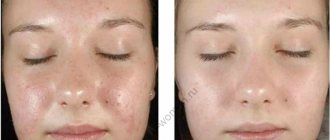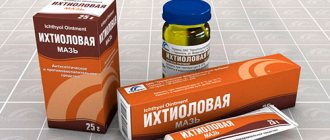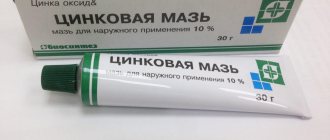Lichen (mycosis) is an infectious disease of the human skin. Appears as a result of contact of microspores of various types of fungi on the skin. It is a mistake to think that lichen planus is an exclusively childhood disease. Adults are no less susceptible to it than children.
The main factors that influence the appearance of lichen are visiting crowded places with high humidity, for example, swimming pools, saunas, baths, gyms. Domestic and street animals are also often carriers of infections. Often, pathologies of the thyroid gland, diabetes mellitus, and hormonal imbalances in the body can contribute to infection of a person’s skin with lichen.
Symptoms of lichen
What symptoms indicate that you have contracted lichen planus? It should be noted that lichen affects not only the skin of the body, but also mucous membranes, nails and even human hair. As a rule, any type of this disease begins with the appearance of the following symptoms:
- minimal increase in body temperature;
- the appearance of chills, mild headache, and sometimes nausea;
- later the temperature rises, and itching appears in certain places (face and body, less often - limbs);
- after a few hours, bubbles will appear at the site of redness, which soon burst and only a crust remains.
The best sprays for ringworm
In this form, the medicine can be used for various forms of the disease. The advantages include fast absorption and the ability to use on the scalp. The use of such products eliminates the need for a long washout and does not spoil the hair color. However, they are often contraindicated for pregnant women. Testing the characteristics of the drugs allowed us to identify the 2 best products from the 5 nominees.
Thermikon
The medicine is released in the form of a clear, colorless or light yellow liquid, 1 ml of which contains 10 mg of terbinafine hydrochloride. The substance is a chemically synthesized antifungal agent. It disrupts the biosynthesis of the cell membrane of dermatophytes and some types of fungi, which leads to death. Less than 5% of the dose is absorbed and therefore does not enter the blood. It is prescribed to children only from the age of 12. The main indications for use are lichen versicolor and fungal infections.
Advantages
- Does not affect the ability to drive vehicles;
- Ease of use;
- Average price;
- Short duration of treatment;
- Effective;
- Safe.
Flaws
- Smell of ethyl alcohol;
- Contraindications.
The dosage is determined taking into account the severity of the disease. Usually it is 2 times a day for 1 week. Spray the product onto the affected area and adjacent areas of healthy skin. The latter is thoroughly cleaned and dried before the procedure. The effectiveness of the spray was confirmed by 95% of respondents.
Terbinafine
The drug is considered the original, on the basis of which the generic Thermikon was created. Their composition, with the exception of a number of excipients, is identical. The medicine is released in a glass bottle with a dosing pump, the volume of which is 10 or 20 g. There are no data on the safety of use in children, so the spray is prescribed for this category of patients in exceptional cases. The course of treatment is also 2 weeks.
Advantages
- A decrease in the severity of symptoms is noted on the first day of treatment;
- Low price;
- The course lasts no more than 2 weeks;
- Convenient to use.
Flaws
- Risk of developing an allergic reaction.
The spray has earned only positive user reviews. It quickly and easily helps cure lichen, the volume is enough for a course, the price corresponds to the quality. All patients recommend purchasing the product.
Treatment of lichen in adults
The diagnosis of lichen planus is made by a dermatologist; only in some cases additional tests are necessary. If the diagnosis is made incorrectly, then treatment can bring a negative result, which can lead to the transition of the disease to the chronic stage.
Treatment of lichen planus should be comprehensive. Only a doctor can select a remedy that will help to cope with the disease as much as possible, taking into account the stage of infection and its extent within certain areas of the body.
Rating of remedies for lichen
Taking into account the cause of occurrence, 7 types of pathology are distinguished. The most dangerous are considered viral infections, which are characterized by rapid spread and long-term treatment. Therapy is aimed at alleviating symptoms, increasing immunity, and eliminating the irritant. The rating of the best treatments for lichen in an adult or child is based on the results of comparative tests of the following characteristics of the drugs:
- Pharmacological group;
- Release form;
- Indications;
- Presence and type of side effects;
- Packaging volume;
- Availability;
- Active substance;
- Number of contraindications;
- Impact on human psychomotor reactions;
- Terms of Use;
- Interaction with drugs from other pharmaceutical groups;
- Best before date.
The price/package volume ratio was taken into account. This indicator often determines the need for additional purchase of funds for a course of treatment. All top drugs are divided into 3 categories based on the release form. Each section provides a description, pros and cons of the medication according to reviews from doctors and patients.
The best antiviral agents
How it works
Ichthyol, which is part of the ointment, has the ability to draw foreign substances from the skin. Therefore, it is actively prescribed for boils, acne, and skin infections.
The ointment also has an antiseptic and anti-inflammatory effect. Due to this, ointment and suppositories are used for varicose veins and inflammatory urological and gynecological diseases. In addition, the ointment can reduce pain, so it is used for arthritis and neuralgia.
The ointment has antibacterial properties and is prescribed for cases of infection by staphylococci and streptococci. Fungi are also sensitive to ichthyol, so the ointment is used for candidiasis and onychomycosis.
What is included in Ichthyol ointment?
The ointment consists of ichthammol and medical petroleum jelly. Ichthammol is a substance made from oil shale resins. It is obtained by gasification and semi-coking. The root of the word is related to the Greek word for fish, which explains the presence of remains of ancient reptiles in the shales.
Ichthyol has been used in medicine since the end of the nineteenth century, thanks to the scientist P. Unn. Initially, a German doctor used it to treat gout, rheumatism and skin diseases. Later it became firmly established in medical practice; an alcohol solution of ichthyol was used in the treatment of migraines. And then tablets with ichthyol appeared, which were taken orally to treat asthenia.
Now there are suppositories with ichthyol and ointment, which are used exclusively externally.
Causes of pityriasis rosea
Currently, the exact cause of the pathology is not clear. Many representatives of the medical community believe that the development of pityriasis rosea occurs under the influence of the herpes virus, but this opinion has not yet been confirmed. It is believed that the disease can be triggered by taking certain medications.
Risk factors also include:
- Decreased immunity due to acute respiratory viral infections, sore throat, colds;
- Presence of chronic diseases;
- Stressful situations;
- Disruptions in the metabolic process;
- Illiterate skin care;
- Allergic manifestations;
- Hypovitaminosis;
- Injuries and damage to the skin, including insect bites.
Pityriasis rosea develops due to hypothermia or as a consequence of vaccination. Sometimes the cause is pathologies of the digestive system.
Make an appointment with a dermatologist by phone or by filling out the online form
| Select a clinic | Skin rash | Dermatologist at the clinic | Dermatologist at home |
Diagnostics
It is not difficult to make a primary diagnosis if you know what ringworm looks like. To clarify the diagnosis use:
- analysis of clinical data;
- results of luminescent analysis;
- microscopic studies;
- sowing material.
In some cases, the source of infection is difficult to determine, since the incubation period ranges from 2 to 45 days. Symptoms may appear on the head, neck, arms, legs, including the palms, soles of the feet, groin areas and folds. Fungal infection causes itching, discomfort in the area of inflammation, and creates psychological discomfort.
Which remedy for ringworm is better to buy?
The choice of drug depends on the type, severity of the pathology, and the age of the person. It is easier to treat children's lichen with external means, because not every child agrees to take pills. The option of sprays at this age is out of the question; they are allowed only from 12 years of age. Treatment with ointments is often used for mild pathology; in severe cases, they are used in combination with tablets. Sprays are chosen by patients for whom rapid absorption of the product is important. The following recommendations will help make the choice of medication easier:
- The best drug for the treatment of herpes zoster in adults and children is Acyclovir;
- The safest composition is Gistan;
- Inexpensive but effective remedy - Sulfur-tar ointment;
- Broad spectrum of action – Clotrimazole;
- The best ointment for lichen in children is Mikoseptin;
- The most convenient treatment option is Terbinafine;
- The best medicine for ringworm is Griseofulvin.
Each tool has its own pros and cons. How to treat lichen in children is determined by the doctor in adults after receiving the diagnostic results. All his recommendations must be followed strictly.
Do I need to wash off zinc ointment from my face?
The constant presence of zinc on the skin of the face can lead to dryness and flaking. However, this depends on the individual characteristics of the sebaceous glands. If pathological activity is noted, the zinc ointment may not be washed off, but in this case there is no need to apply foundation and other cosmetics on top of it: firstly, this will clog the pores, and secondly, the compositions of some products may react with zinc, which may lead to chemical reactions between components.
If the ointment is not washed off during the day, be sure to cleanse the skin by washing before the next application. Otherwise, the accumulation of daytime dust in the pores with ointment residues can give rise to a new skin problem.
Prevention
The main measures to prevent ringworm are careful adherence to hygiene procedures:
- Using only your own towels and combs, preventing the child or adult from sharing them and using other people’s hygiene items.
- After visiting swimming pools, bathhouses, and water parks, you should immediately wash with soap, wash and wash the items you used.
- If someone in your home shows signs of ringworm, further infestation should be prevented. His bedding and underwear must be washed separately. All items are thoroughly washed and treated with disinfectants.
- Preventing contact with stray animals, especially cats. According to statistics, about 50% of them are infected with microsporia or are its carriers.
- The patient should be isolated from the team until complete recovery.
- If there is a sick animal in the house, all surfaces must be treated with disinfectant solutions.
With careful prevention, ringworm may not appear in other household members.
Reasons for development
The main causes of ringworm are contact with the pathogen:
- A child aged 4–11 years whose sweat reaction is predominantly alkaline.
- A child or adult with reduced immunity, the presence of scratches, scabs, microtraumas that can become infected.
Most often the carrier is an animal, less often a person. Infection also occurs through objects or personal belongings on which infected hairs, hairs or skin scales remain. Infection is possible through undisinfected hairdressing tools, through soil on which the causative agent of the disease can persist for up to 3 months, during processing of hay. According to statistics, up to 70–80% of cases of the disease occur as a result of contact with stray young cats and kittens.
What tests need to be taken for pityriasis rosea?
The diagnostic method and set of necessary studies are determined by a dermatologist. Typically, the patient takes a blood test to study general indicators. Tests are often ordered to detect antibodies to viral agents, including syphilis and herpes. To exclude fungal damage to the skin, microscopic examination of scrapings from the site of the lesion is carried out.
Additionally, the doctor may prescribe an immunogram if there is a suspicion of a significant decrease in the body's defenses. The cause of pityriasis rosea is an allergic reaction, so testing for allergens is possible. If necessary, the doctor prescribes additional examinations and consultations with specialists. Typically, such measures are taken in case of protracted or atypical course of the pathology.
What is usually meant by the name “ringworm” is fungal diseases of the skin and scalp caused by special pathogens - the fungi Microsporum and Trichophyton. The difference between Microsporia and trichophytosis is that it is usually transmitted to humans from a sick animal, while trichophytosis is transmitted among people. These diseases are united by a clinical picture, which is represented by the appearance of flaky lesions with hair breaking off in the affected area. Specific complications include damage to internal organs when fungi penetrate the systemic bloodstream in weakened patients.
Trichophytosis is an anthroponotic (which means it affects people) fungal disease caused by the fungi Trichophyton violaceum and Trichophyton tonsurans. Infection usually occurs through direct contact with the affected areas of the skin of a sick person, or through the use of contaminated household items. Often the disease spreads when sanitary and hygienic rules are not observed in public places (schools, gardens, saunas, hairdressers).
Microsporia is a zooanthroponotic disease (affects both animals and humans) caused by the fungi Microsporum canis and audouinii. In this case, transmission of the disease occurs through contact with sick animals (fox, rabbit, cat, dog, rodents, sheep) or their fur. The peak incidence is observed in early summer and mid-autumn. Infection from person to person is extremely rare. The prevalence of the disease is higher among children and young women; older people get sick very rarely due to the presence of specific organic acids in the skin.
Predisposing factors for the development of ringworm are various chronic somatic diseases - glomerulonephritis, lupus erythematosus, immunodeficiency states, endocrine pathologies (especially diabetes mellitus, adrenal insufficiency), and many others. Immediate risk factors are work related to processing the wool of wild and domestic animals, contact with street animals, and living with a sick person.
Symptoms of the disease with trichophytosis depend on the form of the lesion. There are superficial and chronic forms of the lesion. With a superficial form of damage to the scalp or smooth skin, small or large lesions with irregular contours appear, covered with small scales (while the inflammatory phenomena are practically not expressed). A characteristic symptom is hair breaking off in the affected areas at a level of 1-2 mm above the skin. Externally broken hair looks like black dots deep in the skin, and the surrounding intact hair looks dull and pale.
The chronic form is characterized by the formation of atrophic areas and hair breakage. Individual pale atrophic lesions may be expressed with hair broken off at the skin level (“symptom of blackheads”), diffuse thinning of hair with unpronounced foci of atrophy may occur, as well as a predominance of thinned areas of skin throughout the head with single broken hair.
With microsporia, large foci of peeling 3-5 cm in size appear in the area of the back of the head or crown, as well as small daughter elements, as well as hair breaking off (unlike trichophytosis - 5 mm above the skin level).
A dermato-venereologist is involved in the diagnosis and treatment of fungal infections of the scalp.
Differential diagnosis is most often carried out with seborrhea, pityriasis rosea, and psoriasis.
For diagnosis, it is important to identify lesions and use techniques to identify the pathogen itself. To do this, a microscopic examination of the obtained material for fungi (scraping from the affected area) is used, which is then repeated several times during therapy. After this, the pathogen is cultivated on nutrient media in order to determine its species. Additionally, a general blood test and biochemical blood test are performed before and after therapy (antifungal drugs have severe toxicity).
For trichophytosis and microsporia, the following treatment regimens are used: Griseofulvin orally in 3 doses until a second negative microscopic examination is obtained. After this, every other day, and then once every 3 days until complete recovery. An alternative drug is Terbinafine or Itraconazole. Ointments with Ciclopirox, Ketoconazole or Bifonazole are used locally. Hair in the lesions is shaved every 5-7 days. Treatment takes an average of 1.5 months. The prognosis is favorable in most cases.
How to use ichthyol ointment against acne
The ointment effectively helps in the fight against acne. If there are single acne on the face, you need to carefully smear the pimple with ichthyol and cover it with cotton wool. After two hours, you need to remove the ointment.
If there are quite a lot of acne on your face, you can make a mask with ichthyol ointment. You need to spread a thin layer over your entire face, avoiding your eyes and lips. After a couple of hours, remove the mask with a cotton swab, wipe the face with cosmetic milk, and then with diluted salicylic alcohol. You can repeat the procedure a couple of times a week.
It is recommended to make a mask before going to bed, because the ointment has an unpleasant odor.
If there is no result within two months after treatment with the ointment, you should consult a doctor.
Description of the disease
Depending on the type of lichen, the rash may be dry or weeping, pale pink or bright red.
Most often, the disease affects the back, face and chest of the child (it is in these areas that the largest number of sweat glands are located). The disease is infectious in origin and is caused by viruses or fungi. The disease most often manifests itself in the spring-summer season, when it is warm and humid outside. At the moment, a large number of varieties of lichen are known. Many of them are highly contagious and potentially dangerous to the child’s immediate environment. That is why, if there is any suspicion of an infectious disease, it is necessary to immediately show the patient to a qualified specialist.










